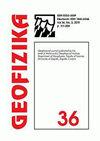The effects of ocean SST dipole on Mongolian summer rainfall
IF 1.1
4区 地球科学
Q4 GEOCHEMISTRY & GEOPHYSICS
引用次数: 2
Abstract
Cross-correlations between inter-annual summer rainfall time series (June to August: JJA) for arid Mongolia and global sea surface temperatures (GSST) were calculated for prediction purposes. Prediction of summer rainfall for four vegetation zones, Desert Steppe (DS), Steppe (ST), Forest Steppe (FS), and High Mountain (HM) using GSSTs for time lags of 5, 6, and 7 months prior to JJA rainfall was evaluated. Mongolian summer rainfall is correlated with global SSTs. In particular, the summer rainfall of FS and HM displayed high and statistically sigtime series of the SST differences between SST dipoles (positive – negative) with the summer rainfall time series was larger than the original correlations. To preused. Time series of the SST difference that represents the strength of the dipole were used as input to the ANN model, and Mongolian summer rainfall was predicted 5, 6, and 7 months ahead in time. The predicted summer rainfall compared reasonably well with the observed rainfall in the four different vegetation zones. This implies that the model can be used to predict summer rainfall for the four main Mongolian vegetation zones with good accuracy.海洋海温偶极子对蒙古夏季降水的影响
为了预测目的,计算了干旱蒙古的年际夏季降雨时间序列(6月至8月:JJA)与全球海面温度(GSST)之间的相互关系。评估了在JJA降雨前5、6和7个月使用GSST对沙漠草原(DS)、草原(ST)、森林草原(FS)和高山(HM)四个植被区夏季降雨量的预测。蒙古夏季降雨量与全球SST相关。特别是,FS和HM的夏季降雨量显示出较高的SST偶极子之间的SST差异(正-负)与夏季降雨量时间序列的统计sigtime序列大于原始相关性。预先使用。代表偶极子强度的SST差的时间序列被用作ANN模型的输入,并提前5、6和7个月预测了蒙古夏季降雨。预测的夏季降雨量与四个不同植被区的观测降雨量比较合理。这意味着该模型可以用于预测蒙古国四个主要植被区的夏季降雨量,具有良好的准确性。
本文章由计算机程序翻译,如有差异,请以英文原文为准。
求助全文
约1分钟内获得全文
求助全文
来源期刊

Geofizika
地学-地球化学与地球物理
CiteScore
1.60
自引率
0.00%
发文量
17
审稿时长
>12 weeks
期刊介绍:
The Geofizika journal succeeds the Papers series (Radovi), which has been published since 1923 at the Geophysical Institute in Zagreb (current the Department of Geophysics, Faculty of Science, University of Zagreb).
Geofizika publishes contributions dealing with physics of the atmosphere, the sea and the Earth''s interior.
 求助内容:
求助内容: 应助结果提醒方式:
应助结果提醒方式:


